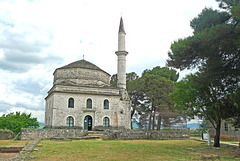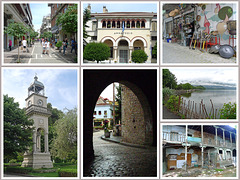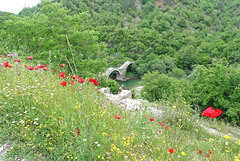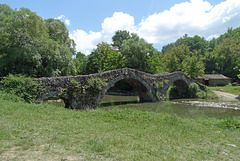Jaap van 't Veen's photos
Greece - Matsouki, Vyliza Monastery
| |
|
|
|
The Vyliza (or Viliza) monastery is located near the village of Matsouki. It is built in a wild landscape on an altitude of more than 1.000 meters, overlooking over a gorge of Kallaritikos river. The name “Viliza” - from the Latin word “vigilo”, which means “guardian” - was given to the monastery. Its location and fortuitous construction justify the name.
Most probably the monastery was founded in the 11th century. But the most ancient written testimony of Vyliza is the icon of St. John the Baptist, dating back to 1676. The monastery was one of the most important in Epirus with a rich library and a great participation in the local community. The monastery has many cells around the catholicon in a rectangular courtyard. The little church has splendid frescoes, dating back to 1793. The precious icons of the church are replicas. The original icons are kept safely in a museum in the neighboring village of Matsouki.
In 1893 the monastery was abandoned and then destroyed. Since 1981 the monastery has been restored.
To visit the monastery, we first had to collect the key from a cafe in the village of Matsouki. After parking the car at the roadside, we could start a walk to the monastery. The stone-paved path went constantly up and down and counted many steps. When it started raining on the way back, it was quite a challenging walk of almost 2 kilometres. (See PiPs on the right side of the main picture)
Greece - Arta Bridge
| |
|
|
|
The Bridge of Arta is a stone footbridge crossing the Arachthos river on the outskirts of town. The current bridge is Ottoman and most probably built from 1602 till 1606. However the history of a bridge on that place goes even back to the Roman period.
From the annexation of Arta in 1881 to the outbreak of the First Balkan War in 1912, the highest point of the bridge was the border between the Ottoman Empire and the Kingdom of Greece.
The bridge has a length of 145 meters and the width is 3.75 meters. It has four semicircular arches with no symmetry. The Bridge of Arta received many restorations and additions throughout its history. A major restoration took place during the decade of 1980, after which the bridge got back its beauty.
A folk ballad tells a story of how builders were building the bridge, but its foundations would collapse each night. Finally a bird with a human voice informed the master builder that he should sacrifice his wife in order to complete the construction. She was buried alive in the foundations of the bridge. She first curses the bridge, but then turns the curse into a wish once she realizes her brother may cross the bridge. Thus the sacrifice is fulfilled and the spirits of the river all the bridge to be built successfully.
In 1931, during repairs, a small room was discovered in one of the bridge pillars: it is claimed that a skeleton was indeed found there.
Greece - Lake Kastraki
| |
|
|
|
Lake Kastraki is an artificial lake in western Greece in the Acheloos riverbed at the junction of Inachos tributary. The lake is fed by the rivers Acheloos and Inachos. .It was formed by the Kastraki Dam, which was completed in 1969. The area of the lake is about 28 aquare kilometers and its maximum capacity is 950,000,000 m³ of water. It is used for the generation of hydroelectric power, saving considerable energy by not using oil without harming the environmet.
Although Lake Kastraki is artificial it fits fully in the natural environment offering an evergreen scenery.
Greece - Koronisia
| |
|
|
|
The picturesque village of Koronisia (or Korakonisia/Kyronisia) was an island until recently. Nowadays it is connected to the sore by Arta by a winding road wit sea on both sides. On one side lies the Amvracian Gulf and on the other the Tsoukalio lagoon with fishing facilities and a lot of bird life. Crossing it was quite an experience and we stopped several times enjoying the great views.
Koronisia itself is a (former) fishing village which offers a lot of quietness, sea life and some local tavernas. The village has about 200 inhabitants. On a hill stands the Panagia Koronisia, one of the oldest Byzantine churches in Arta and an architectural juwel dating back to the late 10th century (although often closed, so told an owner of a taverna me). Nearby one can find the small fortress of Koulia with a remarkable modern architecture, nowadays an event venue. The scenic enviremont is also called “Greek Polynesia”.
Greece - Arta, Panagia Parigoritissa
| |
|
|
|
The church of Panagia Parigoritissa, dedicated to the Annunciation, was built between 1285 and 1289 by the Epirus despot Nikiforos Komninos Doukas and his second wife Anna Palaiologina. It was formerly the katholion (= main church) of the largeStavropegian monastery. It became a dependence of the Kato Panaghia monastery, when it went bankrupt. The church is mentioned for the first time as a convent for nuns 1578.
Seen from outside the church is a large, almost cubic three-storey building, which looks like an Italian palace. It is of the octagonal type with a central dome and also four smaller domes on each corner of the church's flat roof.
The interior of the church is extremely elegant and lavishly decorated with wall paintings, sculptures (16th century) and an iconostasis, which replaced the original marble one. The nave is square and has no internal supports. The dome - adorned with mosaic depictions of the Pantocrator and the Prophets - rests on eight pilasters, on each of them stand three rows of smaller columns. This kind of architecture most probably has not been used to other Byzantine monuments. This makes the church very fascinating and quite unique.
Nowadays Panagia Parigoritissa is a (kind of) museum, where on has to pay a small entrance fee.
Greece - Church of Panagia Vlacherna
| |
|
|
|
The Byzantine Church of Panagia Vlacherna (Virgin Mary Church) is one of the most important Byzantine monuments of the medieval Epirus state. Initially it was dedicated to the Assumption of Mary. The church was initially the catholicon of a women’s monastery. Nowadays it serves at the parish church of the settlement of Vlacherna.
The church is built atop a middle-byzantine era basilica (late 9th – early 10th century). The central arch of which consists as an arch of the current church. In the early 13th century the Vlacherna Church was built as three-aisled wooden roof basilica, which a few years later was transformed into the vaulted type with the addition of the domes. In the second half of the 13th century the narthex was added on the west side.
The nave has important frescoes from the mid 13th century, while the frescoes in the narthex are from the end of the same century. The marble relief iconostasis is of remarkable craftsmanship.
Greece - Kipi, Lazaridis Bridge
| |
|
|
|
The one-arch stone Lazaridis Bridge (also known as Kontodimos Bridge) was built in 1753 and named after Kostas Lazaridis, an owner of a mill, located near the bridge. Mr. Tolis Kontodimos from the nearby village of Vradeto donated for the construction of the bridge. The watermill was used by the people of Kipi, Koukouli, Kapesovo and Vradeto in order to grind the wheat.
The bridge is located in the gorge of the river Vikos near the village of Kipi and connects the village of Kipi with Koukouli. The arch is 15 meters wide and has a height of 7,80 meters. The walkway has a length of 20 meters and is 2,90 meters wide. The bridge is also known as the “Venice Bridge”.
Greece - Arta, Church of St. Theodora
| |
|
|
|
The church of St. Theodora - the patron saint of Arta - is an important Byzantine church. Originally it was the katholikon of a monastery, where Theodora, the wife of Despot of Epirus Michael II Komnenos Doukas (1236-1271), was buried.
The originally church was built - over the ruins of an older structure - in the 11th or 12th century as a three-aisled wooden-roofed basilica. This shape has remained almost unchanged till to this day. Around the year of 1270 Theodora renovated the church by adding the nartex and two pediments of the main church. The open colonnaded exonarthex was added in the lat 13th or early 14th century.
Nowadays the Church of St. Theodora is considered being one of Arta’s most important monuments, not only for its morphology but mainly because this church is like a living connection of the present city with its Byzantine past since it is dedicated to its queen, the city’s Saint Theodora.
Greece - Orraon
| |
|
|
|
Orraon (also Horraon or Horreum) was founded in the 4th century B.C. In 167 B.C. the settlement was destroyed by the Romans, but it was subsequently rebuilt and survived for a short period. In 37 B.C. the town had one hundred houses, twelve streets, and a graveyard. Orraon was abandoned by its people. Its inhabitants were forced to settle in Nikopolis , a nearby city founded by Augustus after his victory in the navel battle of Actium at the mouth of the Ambracian Gulf.
In Orraon most of the houses are still standing, sometimes even two stories high and the street plan is still visible".The town had twelve narrow parallel streets, in the north and south direction, cross two wider streets. The settlement consisted of 100 houses, built of local limestone. The main parts that are visible today are the stone the houses were made of, window frames and door frames. The cistern (PiP5) was located near the main gate.
Orraon is located quite remote and during our visit there we were totally alone. It was very pleasant to walk around among these old houses, surrounded by a colourful landscape with lots of wild flowers.
Greece - Elliniko, Tsoukas Monastery
| |
|
|
|
The Tsoukas Monastery is built near the village of Elliniko on the in the area of Katsanochoria. It dominates at the top of a rocky hill, above the impressive gorge of the Arachthos river, at an altitude of about 900 meter (PiP5.)
The monastery, dedicated to the Nativity of the Virgin, was founded - according to local tradition - by the Emperor Isaac II Angelos in 1190, flourished during the Despotate of Epirus. However, its presence is confirmed during the period of the Ottoman domination, mostly by the date 1668 that is mentioned in a handwritten comment on the statute of the monastery.
It constitutes a monastic complex of fortress construction, that includes the two-storey buildings of the cells, a catholicon, a cistern, a belfry and a chapel dedicated to the Virgin. In the center of the enclosure stands the catholicon. It is a little single-naved church probably of the 17th century. The interior of the catholicon is covered with 18th century frescoes.
During our visit on a Sunday morning, a church service was going on. As the small church can hardly accommodate any visitors, the service was also available for visitors to follow via loudspeakers. Afterwards, there was coffee and “loukoumia” for everyone; a special experience.
Greece - Ioannina, Saint Athanasios Metropolis Chu…
| |
|
|
|
At the location where the Cathedral of Saint Athansios nowadays is located, was a Monastery dedicated to Saint Athanasios the Great. After the failed movement of Dionysios the Philosopher in 1611 and the expulsion of christians from the castle of Ioannina, the church of Saint Athanasios replaced a cathedral inside the castle and became the third cathedral of Ioannina. However, in August 1820 the temple was destroyed by a large fire during the siege of Ali Pasha.
During the presidency of the Metropolitan of Ioannina Ioakeim, in 1832, and at the expense of benefactors, a bigger church was rebuilt from the ground up. The frescoes in the church date back, according to an inscription, to 1835. The ornate wood-carved iconostasis is "baroque", made of walnut wood, and is the work of four wood carvers from Gorgopotamos (Konitsa). The imposing tower-shaped bell tower was built in 1909.
Greece - Koukouli, Noutsos Bridge
| |
|
|
|
The Noutsos Bridge (Γεφύρι Νούτσο) - also called Kokkoros Bridge - is an impressive one-arched bridge located between the villages Koukouli, Dilofo and Kipi. The bridge spans the River Vikos at one of its impressive narrows. There is an inscription with the year of 1750 or 1752. The bridge was paid for by Mr. Noutsos Kontodimos and Mr. Noutsos Karamesinis. Mr. Kokkoros, owner of a nearby mill, donated a sum of money to correct the steep incline of the cobbled walkway in 1910.
The Noutsos Bridge is one of the best stone bridges in the area. It has an impressive arch spanning 24 meters and rising 11,60 meters above the river bed. The walkway has a length of 39 meters and is 2,50 meters wide.
The Noutsos Bridge, although very old, is still in good condition. In 1977, part of the cobbled path was destoyed by unknowns, but fortunately, the archaeological service repaired the damage and the historic bridge still stands there.
Greece - Ioannina, Nisi
| |
|
|
|
The islet on Lake Pamvotis nearby Ioannina is referred to as "Nisaki" (Νησάκι = Greek for "little island"). Inhabitants call it "Nisi" (Νησί = Greek for "lsland"). Nisi (or Nissi) is a small island - 800 by 500 meters - in Lake Pamvotis. It is one of the two lake islands in Greece, which are inhabited. There is only one village - with a couple of hundreds of inhabitants - on the island which with picturesque paved alleys and a lot of tourist shops and restaurants.
Nisi is well known for the Ali Pasha Museum and its monasteries. The first one was built at the end of the 13th century and the island was important monastic center.
The island is accessible by boat from Ioannina (about 10 minute-ride each way) or by a ferry from a nearby shore.
Greece - Ioannina, Fethiye Mosque
| |
|
|
|
The Fethiye Mosque is located in Its Kale , the inner castle in the walled city of ancient Ioannina. It was built immediately after the conquest by the Ottomans in 1430, near the ruins of an early 13th-century Byzantine church. Originally it was a wooden structure, which was replaced in 1611 by a stone building.
The mosque was extensively remodeled in 1795 by Ali Pasha, an Albanian born cruel despot, who made it the main mosque of his palace. The tomb of Ali Pasha and his family is located before the mosque, protected by a solid metal fence.
The mosque has a square plan, with a minaret at the western corner. The prayer hall, covered with a hemispherical dome, has a wooden balcony supported on stone columns. Interior decoration is preserved and the mihrab is particularly striking.
Nowadays the mosque is part of the Byzantine Museum and can be visited.
Greece - Monastery of Panagia Molyvdoskepastos
| |
|
|
|
The history of the Monastery of Molyvdoskepastos goes back in the Byzantine era and was originally built in the 7th century. It is one of the oldest monasteries in Greece. Its founder was the Byzantine emperor Constantine IV Pogonatos. The monastery was renovated in the 14th century by Andronikos Komnenos Doukas Palaiologos. The monastery owes its name from the lead roof it once had: i>molivdoskepasti means “with a roof of lead”. The lead was stolen by Turks to make bullets and was then replaced by slates.
The katholikon (main church) belongs to a complex architectural style and was built in three phases. The original church with three vaults and a dome, was the first to built (11th and 12th century). The middle cross vaulted section was added at the end of the 13th century and in the beginning of the 14th century. Finally, an open narthex was added in the year of 1521 by the inhabitants of a nearby village. The interior of the church is decorated with splendid wall and ceiling paintings of the 14th and 16th centuries. The iconostasis is carved, probably dating back to the 15th century with remarkable icons.
After 1913 the monastery remained without monks, its properties were encroached and its holy artifacts and relics were stolen. In 1943, when the area was bombarded by the Nazis, it was almost razed to the ground. In 1988 the monastery was manned once more by the present day brotherhood.
From the outside the monastery looks (a little bit) like a fortress, due to its walls and gatehouse. It is located about 20 km from the town of Konitsa, some hundred meters away from the Aoos River and the border with Albania.
Greece - Ioannina
| |
|
|
|
The region of Ioannina has been popoulated by Greeks since the Mycenaean era. However the city of Ioannina - often called Yannena - was formally founded by the Byzantine Emperor Justinian in the 6th century AD.
Ioannina flourished following the Fourth Crusade, when many wealthy Byzantine families fled to the city in the early 13th century following the sack of Constantinople. It was part of the Despotate of Epirus from 1358 to 1416, before surrendering to the Ottomans in 1430. Between 1430 and 1868 the city was the administrative center of the Pashalik of Yanina. In the period between the 18th and 19th centuries, the city was a major center of the modern Greek Enlightenment. Ioannina became again part of Greece in 1913 following the Balkan Wars.
The City has a longstanding tradition in commerce and handicraft activities dating back in the 17th century, where merchants from Ioannina traded with important European commercial centers, such as Venice and Livorno, and established commercial and banking houses. During the 18th century, every author of the Greek world, was either from Ioannina or was a graduate of one of the city's schools, and the city created the reputation of being number one City in education.
Ioannina is situated on the western shore of Lake Pamvotis. Nowadays it is the capital and largest city of the region of Epirus with a population of more than 100.000 people. The city has a wealth of attractions and museums with most attractions. The main sight is the “castle” located in the center of the town, this was the heart of the Despotate of Epirus, and the Ottoman vilayet. The (historic) centre of Ioannina offers small traditional shops and houses, and many souvenir shops.
Greece - Kipi, Plakidas Bridge
| |
|
|
|
The Plakidas Bridge (Γεφύρι Πλακίδα) is crossing the Voidomatis River close to the village of Kipi on a site belonging to the village of Koukouli. The stone bridge has three semi-circular arches. The central arch has a span of 13,50 meters and a height of 7,60 meters. The bridge is 64 meters long and 3,20 meters wide.
Plakidas Bridge retained its original triple-arched form despite being almost completely reconstructed over the years.
The first bridge on this location was wooden and built in 1814. A short time later, but unknown when, an abbot from the nearby monastery in Vitsa paid 20.000 “piaster” for the bridge to be rebuilt in stone. The monastery of Profitis Ilias maintained a watermill at this point and the construction of the bridge was done to replace the older bridge, in order to make the passage safer.
Repairs were carried out in 1866 and were paid by Alexios Plakidas. This act is recorded in an old register of “contributors and benefactors to the community and church of Koukouli village”.
Alexios brother and nephew were also contributors. Since that time the Plakidas family has not stopped generous amounts of money to repair the bridge. This explains the bridge’s name, although its official name is Kalogeriko Bridge; which means “Bridge of the abbot”.
Greece - Kipi, Mylos Bridge
| |
|
|
|
The Mylos Bridge (Γεφύρι Μύλου) is located nearby the village of Kipi and crosses the River Bayiotiokos. The villagers used to cross this bridge to get to the local watermill (hence the name: mylos = mill in Greek) and their gardens on the opposite side of the river, or to travel to Ioannina.
Mylos Bridge has three arches. The two largest stand in the river bed and are almost equal in size; the smallest is a flood arch. Looking from left to right the dimensions of each arch are (span and height): 9.60/4.30 meters, 8.30/3,75 meters and 3.90/1.60 meters. The walkway is 41 meters long and 2.30 meters wide. It rises and falls twice, peaking in height over the keystones of the largest arches. The path is protected by vertical arcade stones.
A plaque built into the masonry over the central pier tells that the bridge was completed in June 1748.
Jump to top
- ipernity © 2007-2024
- Help & Contact
|
Club news
|
About ipernity
|
History |
ipernity Club & Prices |
Guide of good conduct
Donate | Group guidelines | Privacy policy | Terms of use | Statutes | In memoria -
Facebook
Twitter


















